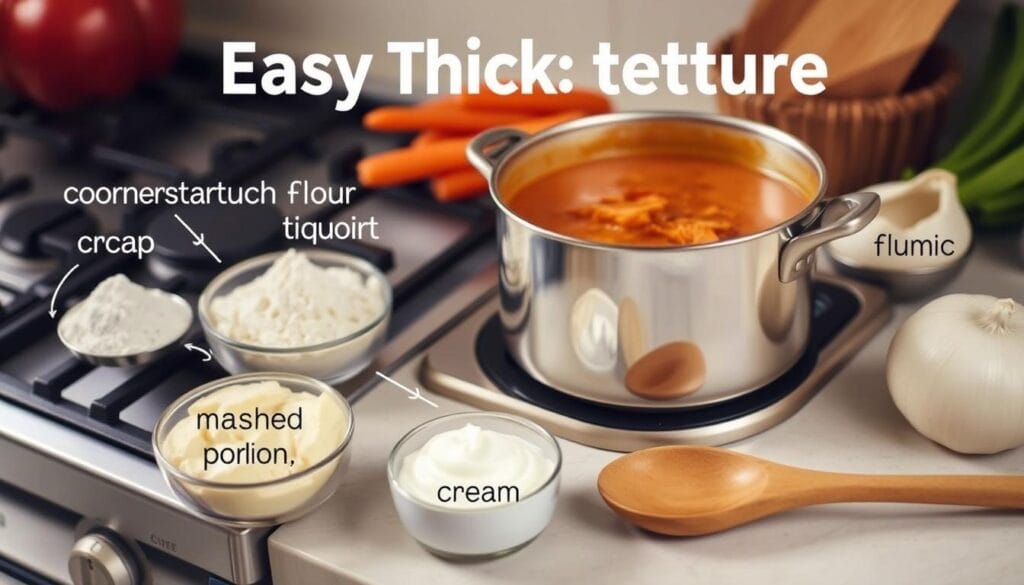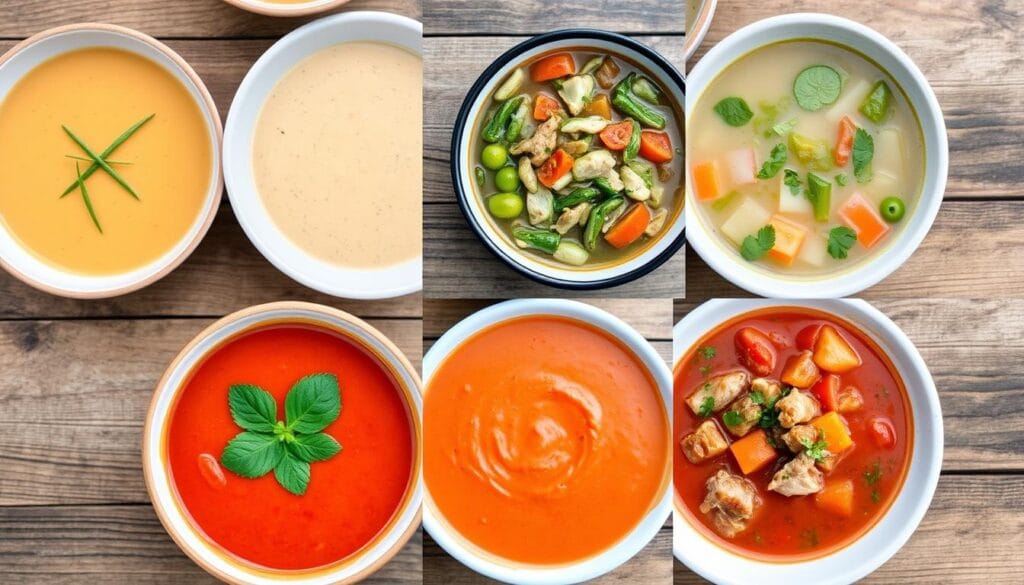Making your soups thick and creamy can elevate their taste and texture, turning a simple dish into a satisfying meal. If you’ve ever wondered how to thicken soup for that perfect consistency, this guide is here to help. From instant mashed potatoes to creamy additives like yogurt or heavy cream, there are plenty of ways to achieve the richness you desire.
This article will walk you through simple methods and ingredients to create deliciously thick soups. Whether you’re making a hearty potato soup or a silky tomato bisque, these tips and tricks will make your soups better than ever.

Table of contents
- Understanding Soup Consistency: Why Thickness Matters
- What Makes Soup Thick and Creamy? Key Ingredients and Methods
- How to Thicken Soup: Methods for Creamy Perfection
- Simple Techniques to Thicken Soups Without Flour
- The Power of Blending for Silky Soups
- Adding Ingredients for Thickness: Potatoes, Lentils, and More
- Thickening Soup Without Dairy or Starches
- Utilizing Flour and Cornstarch
- FAQ
- Conclusion: Mastering the Art of Creamy Soups
Understanding Soup Consistency: Why Thickness Matters
Soups can range from light and broth-like to thick and creamy. A thick soup is rich and hearty, making it a filling meal. The smoothness and thickness of creamy soups add to their comfort.
The texture of a soup comes from how its ingredients interact. Cooking methods and ingredient ratios greatly impact the soup’s thickness. Starchy veggies, legumes, or dairy can make soups creamy and more filling.
Here’s a table showing common soup consistencies:
| Consistency Type | Description | Examples |
|---|---|---|
| Broth | Thin, liquid base, often clear | Chicken broth, vegetable broth |
| Chunky | Contains visible chunks of ingredients | Minestrone, vegetable soup |
| Thick | Rich, smooth consistency, filling | Potato soup, split pea soup |
| Creamy | Silky texture, often enriched with dairy or alternatives | Tomato bisque, cream of mushroom |

What Makes Soup Thick and Creamy? Key Ingredients and Methods
Several key elements make soup thick and creamy. Understanding what contributes to soup thickness helps you choose the right ingredients and methods.
Starch-Based Ingredients for Natural Thickness
Starchy vegetables like potatoes, sweet potatoes, or carrots help naturally thicken soups. Rice and lentils are other starch-rich options that also boost nutrition.
Dairy for Rich Creaminess
Heavy cream, sour cream, or yogurt adds a luxurious texture. For dairy-free options, coconut milk and almond milk are great alternatives.
Blending Techniques for Perfect Smoothness
Blending part or all of your soup creates a silky texture. Immersion blenders are especially helpful for achieving consistent results.
How to Thicken Soup: Methods for Creamy Perfection
There are many ways to thicken soup, each offering its own benefits. Choosing the right method depends on the type of soup you’re making and the consistency you want.
Using Instant Mashed Potatoes or Rice
Instant mashed potatoes dissolve easily, adding body and creaminess. Cooked rice can be blended into the soup for a subtle thickening effect.
Exploring Creamy Additives
Adding dairy products like heavy cream or coconut milk enhances the soup’s flavor while improving its texture. Stir them in toward the end of cooking to avoid curdling.
Roux and Slurries for Traditional Thickening
Slurry: A combination of cornstarch or arrowroot powder mixed with cold water, added to soups for instant thickening.
Roux: A mix of butter and flour cooked to remove the raw taste.
Simple Techniques to Thicken Soups Without Flour
Thickening soup is easy with the right techniques. About 30-40% of soup recipes need thickening for the perfect consistency. Try different simple soup thickening methods to make your dishes better without adding complexity.
Wondering how to thicken soup without flour? There are many alternatives. Potatoes, sweet potatoes, and cooked rice are natural thickeners. Legumes like red lentils and white beans also add health benefits and texture.
Many easy soup hacks can make your soup creamy. A slurry made from starch and cold water can be added slowly to your soup. This method prevents clumps. Egg yolks can also enrich flavor and texture.
For those on special diets, potato starch and gluten-free bread are good options. Stale bread or bread crumbs can thicken your soup and add flavor. Always add thickeners slowly to avoid over-thickening and to control the soup’s consistency.
| Thickening Method | Main Ingredient | Suitable For |
|---|---|---|
| Potatoes | Yukon Gold potatoes | Vegetable and meat-based soups |
| Lentils | Red lentils | Hearty soups and stews |
| Slurry | Arrowroot powder | Creamy soups |
| Egg Yolks | Fresh eggs | Chowders and rich soups |
| Stale Bread | Any kind of bread | Rustic soups |
With these techniques, you can easily adjust your soup’s thickness and keep it flavorful. Try these methods and find what works best for you and your recipes.
The Power of Blending for Silky Soups
Blending soup makes it creamy and enhances texture. Knowing how to blend soup right can make your dishes better. The right tools are key to getting the perfect consistency.
Using a Blender for Chunky Soups
A standard blender is great for thick soups. Let the soup cool a bit before blending. Blend in batches to avoid spills.
For smooth soups, blend until it’s fully smooth. For chunky soups, pulse the blender to keep some texture. This adds a nice bite.
Food Processor Versus Immersion Blender
Choosing between a food processor and an immersion blender depends on your soup and preference. A food processor works well for big batches and chopping. But, immersion blenders are popular for a reason.
Here are some immersion blender tips:
- Blend directly in the pot for easy cleanup.
- Use a deep pot to prevent splatter.
- Move the blender up and down for consistent texture.
Immersion blenders blend soup right in the pot. This keeps the soup hot and blends smoothly. It’s perfect for delicate textures.
| Blender Type | Pros | Cons |
|---|---|---|
| Countertop Blender | Great for large batches, versatile | Requires transfer of soup, more cleanup |
| Immersion Blender | Easy to use, blends directly in pot | Limited power for very thick mixtures |
| Food Processor | Good for chopping, control over texture | Can be cumbersome, may not blend as smooth |
Choosing the right blender for your soup is key to success. Trying different methods can help you get the texture you want. This leads to delicious results.
Adding Ingredients for Thickness: Potatoes, Lentils, and More
To thicken your soup naturally, use starchy or fibrous ingredients. Each option offers unique benefits and flavors.
Potatoes as a Classic Soup Thickener
Potatoes are a go-to choice for thickening soups. Yukon Gold or Russet potatoes work best. Mash or blend them for a creamy consistency.
Lentils and Rice for Heartiness
Lentils add protein and fiber while thickening the soup. Rice absorbs liquid and creates a velvety texture. Add them raw or cooked, depending on your preference.
| Ingredient | Benefits | Preparation Method |
|---|---|---|
| Potatoes | Creates a creamy texture; enhances body | Cube or mash and add during cooking |
| Lentils | High in protein; thickens naturally | Add dried or cooked lentils; simmer |
| Rice | Subtle thickness; nutritious | Incorporate cooked rice or raw for a hearty texture |
Thickening Soup Without Dairy or Starches
Dairy like cream and yogurt are great for thickening soup and adding flavor. They make the soup creamy, making it taste better. It’s important to know when to add them so they mix well without curdling.
When to Add Cream to Your Soup
Adding cream at the right time is key for the right texture. Add it towards the end of cooking to keep its flavor. Start by cooling the soup a bit, then slowly add the cream while whisking.
If the soup is too hot, it might curdle. So, let it cool a bit before adding the cream.
Exploring Yogurt as an Alternative
Yogurt in soup thickens it and adds a tangy taste. To avoid curdling, warm the yogurt with a bit of soup first. This makes it blend smoothly.
Yogurt-based creamy potato soup is quick and easy. It uses potatoes like Yukon Gold or Russet. It’s also good for those who need dairy-free options.

| Ingredient | Function | Tips for Use |
|---|---|---|
| Cream | Thickens and adds richness | Add towards end of cooking |
| Yogurt | Thickens with a tangy flavor | Temper before adding to soup |
| Coconut Milk | Provides creaminess and dairy-free option | Use in place of cream for vegan recipes |
Utilizing Flour and Cornstarch
Thicken soup with flour and cornstarch are top picks for home cooks. They each bring unique benefits to your recipes. Knowing how to use them right can help you get the perfect consistency without changing the taste.
Best Practices for Using Flour
To thicken soup with flour, you make a roux. Mix equal parts of butter and flour, like 1/4 cup each. Cook it for 1-2 minutes to get rid of any raw flour taste.
Slowly whisk in your soup broth to avoid clumps. You can also make a slurry with flour and water or stock. This is a great flour alternative for soup.
Tips for Perfectly Thickened Soups
Cornstarch is great for thickening soups. To use it well, mix it with cold water in a 1:1 ratio. Then, add the slurry to your soup near the end of cooking.
Remember, cornstarch thickens quickly. It can also be replaced with tapioca flour (1:2 ratio) or rice flour (1:3 ratio).
| Thickening Agent | Recommended Ratio | Notes |
|---|---|---|
| Flour | 1:1 with butter (e.g., 1/4 cup each) | Cook for 1-2 minutes to remove raw taste |
| Cornstarch | 1:1 with cold water for slurry | Add toward the end of cooking |
| Tapioca Flour | 1:2 (for creamy soups) | Good alternative for cornstarch |
| Rice Flour | 1:3 (compared to cornstarch) | Works well for thickening |
| Potato Starch | 1:1 (with cornstarch) | Can also be used with mashed potatoes |

FAQ
Several factors make soup thick and creamy. Starches, fats, and proteins are key. Ingredients like potatoes and cream add to the texture and richness.
Heavy cream is top for thickening soup. Its high fat content makes it creamy and rich. Coconut milk or sour cream offer different tastes.
Chefs often use instant mashed potatoes to thicken soup. They dissolve well and blend smoothly, avoiding lumps.
Two ways to thicken are using starches like cornstarch slurry or making a roux. Both methods thicken without changing the flavor much.
To thicken without flour, try pureed veggies, instant mashed potatoes, or starches like rice. Dairy products or an immersion blender also work well.
To thicken with flour, make a roux by cooking flour and fat until bubbly. Then, slowly whisk in the soup, stirring to avoid lumps.
thicken soup by adding starches, dairy, blending parts, or using flour and cornstarch. Each method has its benefits.
Thicken soup by adding starches, dairy, blending parts, or using flour and cornstarch. Each method has its benefits.
Thicken soup by adding starches, dairy, blending parts, or using flour and cornstarch. Each method has its benefits.
To thicken with potato, peel and cube potatoes, then cook them in the soup. Blend them with a masher or blender for creaminess.
Conclusion: Mastering the Art of Creamy Soups
As we wrap up our look at thickening soup, remember there are many ways to do it. We’ve talked about using starches and creamy ingredients. We’ve also seen how blending can make your soup just right.
Each method brings its own taste and texture. This lets you make your soup just how you like it. It’s all about finding the perfect balance for you.
Creating creamy soups is all about getting the flavor and texture right. Try adding potatoes, lentils, or flour to your soup. This can make your cooking at home even better.
Don’t forget the tips for thickening soups. Using flour or adding milk and cream can change your soup’s texture. The options are endless.
Start experimenting with thickening your soups. Let your creativity shine. With the right techniques, every soup can be a special treat. Enjoy making soups that are both tasty and satisfying!

